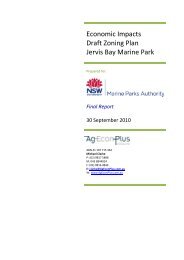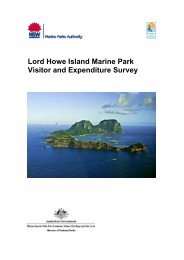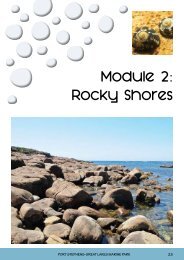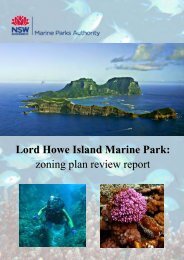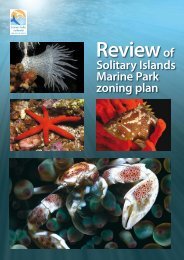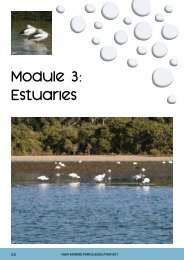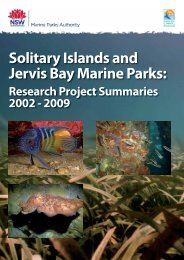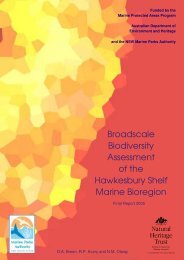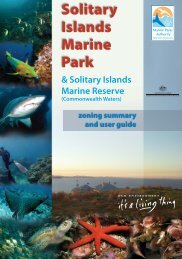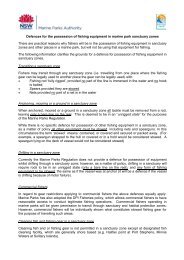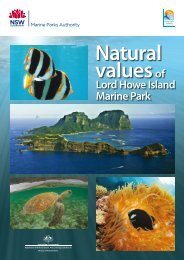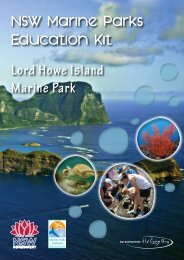Natural values of the Solitary Islands Marine Park - Marine Parks ...
Natural values of the Solitary Islands Marine Park - Marine Parks ...
Natural values of the Solitary Islands Marine Park - Marine Parks ...
- No tags were found...
You also want an ePaper? Increase the reach of your titles
YUMPU automatically turns print PDFs into web optimized ePapers that Google loves.
Figure 37.Station Creek.5 Estuarine ecosystemsEstuaries are places where freshwater creeks and rivers meet <strong>the</strong> sea. In <strong>the</strong>ir naturalstate, <strong>the</strong>y are productive systems supporting high levels <strong>of</strong> floral and faunal diversityand provide important nursery grounds for many species. The 15 estuaries in <strong>the</strong>marine park are ei<strong>the</strong>r:• barrier lagoons, which have larger catchment areas, large variations in salinity, and ahigh diversity <strong>of</strong> marine and brackish water plant species, or;• intermittently closed and open lakes and lagoons (ICOLLs), which have smallercatchment areas, lower average salinity, brackish to fresh waters, a lower diversity <strong>of</strong>marine vegetation, and a higher diversity <strong>of</strong> brackish and fresh water vegetation.Sandon River, Wooli Wooli River, Corindi River, Moonee Creek and C<strong>of</strong>fs Creek arebarrier lagoons that, in most cases, are permanently open. Station Creek, ArrawarraCreek, Darkum Creek, Woolgoolga Lake, and Hearnes Lake are ICOLLs.The benthic macr<strong>of</strong>aunal communities in <strong>the</strong> barrier lagoons and ICOLLs are verydifferent. Significant differences between <strong>the</strong>se two types are maintained throughtime, but are not as great when <strong>the</strong> ICOLLs are open. There are also macr<strong>of</strong>aunalcommunity differences between each individual estuary. These differences in andbetween estuary types are caused by catchment size, which influences environmentalconditions, with each estuary having highly individual characteristics (Hastie andSmith 2006). Nine key species, all common estuarine fauna along <strong>the</strong> coast <strong>of</strong> NSW,are consistently responsible for driving <strong>the</strong>se spatial and temporal differences (Hastie2006).Within each estuary, <strong>the</strong>re are also differences in macr<strong>of</strong>aunal communities movingfrom downstream to upstream in response to changes in environmental conditions(Hastie and Smith 2006).Station Creek is unique among <strong>the</strong> larger ICOLLs in <strong>the</strong> marine park. It is <strong>the</strong> mostextensive ICOLL, and it contains mostly freshwater vegetation (Figure 37). Althoughmany ICOLLs are affected by human activity due to <strong>the</strong>ir small size and being closedto tidal flushing for sometimes extended periods <strong>of</strong> time, <strong>the</strong> catchment <strong>of</strong> StationCreek is surrounded by Yuraygir National <strong>Park</strong>, meaning it is one <strong>of</strong> <strong>the</strong> catchmentsleast affected by human activity. This contributes to <strong>the</strong> overall high environmentalhealth <strong>of</strong> this estuarine system.The adjacent position <strong>of</strong> Yuraygir National <strong>Park</strong> hasstrongly benefited <strong>the</strong> health <strong>of</strong> estuaries in <strong>the</strong>nor<strong>the</strong>rn end <strong>of</strong> <strong>the</strong> marine park. For example, withrelatively little development within its catchment,and 50% <strong>of</strong> <strong>the</strong> catchment protected, <strong>the</strong> SandonRiver was classified as near pristine during <strong>the</strong>National Land & Water Resources Audit (GeoscienceAustralia 2007).Estuaries are important areas <strong>of</strong> productivity incoastal environments, exporting nutrients on whicho<strong>the</strong>r inshore marine environments rely. Estuariesprovide key nursery grounds and adult habitat formany species <strong>of</strong> marine life. More than 100 fishspecies have been recorded in marine park estuariesduring biodiversity surveys undertaken by NSWFisheries in 1995 (Gray et al 1995), and between



